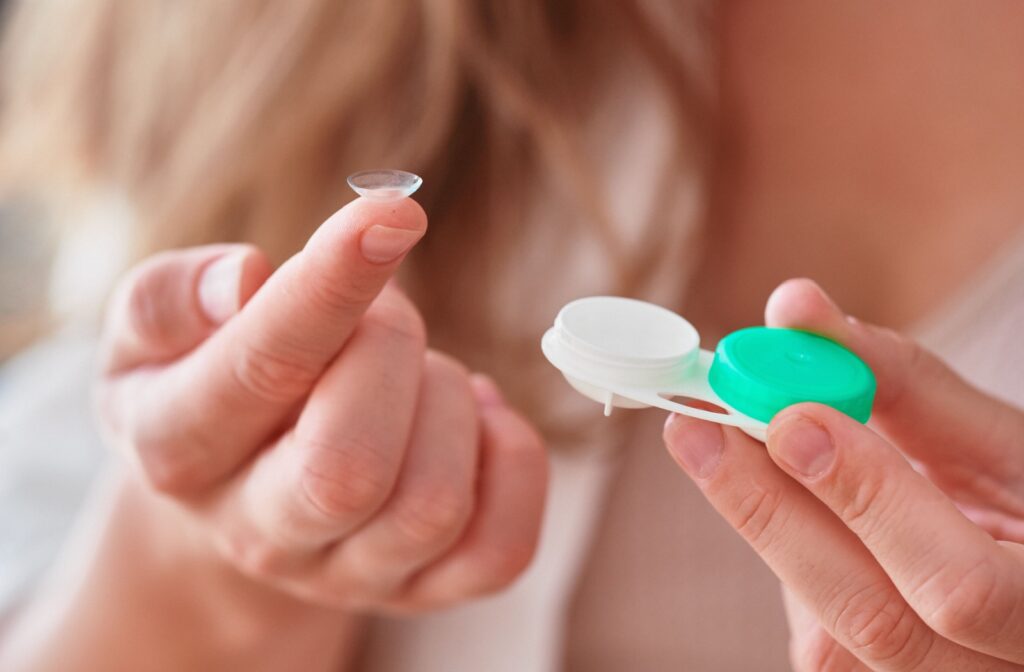Contact lenses are meant to provide crisp, convenient vision, but they can sometimes lead to discomfort that disrupts daily life. Whether it’s dryness, irritation, or blurry vision, these symptoms are more common than many realize.
Contact lens discomfort is often caused by dryness, poor fit, lens material sensitivity, or underlying eye conditions, and most cases can be addressed with the right guidance and care. Identifying the source of discomfort helps support long-term eye comfort and healthy lens wear habits.
What is Contact Lens Discomfort?
Contact lens discomfort manifests in various ways, from mild irritation to significant discomfort that interferes with daily activities. The sensation might feel like:
- Dryness or grittiness
- Burning or stinging
- Excessive tearing
- Blurred vision that comes and goes
- Feeling like something is stuck in your eye
- Sensitivity to light
These symptoms can occur immediately upon insertion, develop throughout the day, or appear after weeks or months of comfortable wear. The timing and nature of your discomfort provide valuable clues about the underlying cause.
Leading Causes of Contact Discomfort
Here are some of the reasons that you or your loved one might be experiencing contact lens discomfort:
Dry Eyes
Dry eyes represent the most common cause of contact lens discomfort. Your tear film consists of three layers (oil, water, and mucus) that work together to keep your eyes moist and comfortable. When this delicate balance is disrupted, contacts can feel uncomfortable or even painful.
Several factors contribute to dry eyes in contact lens wearers:
- Environmental factors such as air conditioning, heating systems, wind, and low humidity can accelerate tear evaporation. Digital device use also reduces blink rates, leading to insufficient tear distribution across the eye surface.
- Age-related changes naturally decrease tear production, particularly in individuals over 40. Hormonal fluctuations, especially in women during menopause, can also affect tear quality and quantity.
- Medications including antihistamines, decongestants, blood pressure medications, and antidepressants can reduce tear production as a side effect.
Poor Lens Fit
An improperly fitted contact lens creates mechanical irritation against the eye’s surface. Signs of poor fit include:
- Lenses that move excessively with blinking
- Persistent awareness of the lens in your eye
- Frequent lens displacement or loss
- Red marks on the eye after lens removal
Contact lens fitting requires precise measurements of your eye’s curvature, diameter, and other unique characteristics. Even small deviations from optimal fit parameters can result in significant discomfort.
Lens Material Incompatibility
Different contact lens materials interact uniquely with individual tear chemistry. Some people develop sensitivity to specific lens materials or their surface treatments, leading to discomfort even when the fit is correct.
Silicon hydrogel lenses, while offering superior oxygen transmission, may feel stiffer initially compared to traditional hydrogel materials. Conversely, some wearers find daily disposable lenses more comfortable due to their thinner design and lack of protein buildup.
Underlying Lens Conditions
Several eye conditions can exacerbate contact lens discomfort:
- Allergic conjunctivitis causes inflammation and increased mucus production, making lens wear uncomfortable. Seasonal allergies, pet dander, or dust mites commonly trigger these reactions.
- Blepharitis, inflammation of the eyelid margins, affects tear film stability and can introduce bacteria that adhere to contact lenses.
- Meibomian gland dysfunction impairs the oil layer of tears, leading to rapid tear evaporation and dry eye symptoms.

Treatments & Prevention for Contact Lens Discomfort
Treatment Options
If your contacts feel uncomfortable, the first step is a thorough evaluation by your eye care provider. This includes checking your tear film, eyelid health, blinking patterns, and how well your current lenses fit. Advanced tools like corneal topography and tear film analysis can reveal subtle issues that affect comfort.
Based on what’s found, your doctor may recommend:
- Switching to a different lens material that suits your eye chemistry
- Adjusting your wearing schedule to reduce strain
- Using lubricating drops made for contact lens wearers
- Treating related conditions like dry eye, allergies, or eyelid inflammation
- Improving eyelid hygiene if blepharitis or meibomian gland dysfunction is present
Everyday Habits That Help Prevent Discomfort
Comfort depends just as much on how you care for your lenses and your environment. To avoid irritation:
- Always use fresh, recommended cleaning solution
- Replace lenses on schedule and avoid wearing them overnight if not designed for it
- Wash hands before handling lenses
- Never use tap water or saliva to clean or store lenses
Environmental and lifestyle tips also make a difference:
- Use a humidifier in dry indoor spaces
- Take screen breaks using the 20-20-20 rule
- Wear sunglasses in windy conditions
- Stay hydrated and eat foods rich in omega-3s
- Get enough sleep to support tear production
With the right care and professional support, most contact lens discomfort can be resolved or reduced.
Moving Forward With Comfortable Vision
Contact lens discomfort is common, but in most cases, it can be resolved with the right diagnosis and care. A comprehensive eye exam can help identify the cause and guide you toward effective solutions.
Book an appointment with Total Vision Hercules today to get back to clear, comfortable lens wear.



